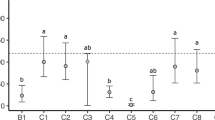Abstract
This study evaluates aqueous uranium (U) toxicity in Ceriodaphnia dubia exposed to surface water collected from two creeks located in U-rich areas of Yukon, Canada. Water for toxicity testing was collected at two times of the year to represent water quality characteristics generally observed during open-water (high flows) and winter baseflow water (low flows) seasons. Collected water was transferred to the toxicological laboratory and spiked with U to achieve nominal concentrations of 50, 150, 350, 500, 650, 800, and 1000 µg U/L. Toxicity endpoints included lethal concentrations (LC50) for survival, in addition to no observed effect concentration (NOEC) and lowest observed effect concentration (LOEC) for reproduction. All derived toxicity endpoints were significantly higher than applicable Canadian water-quality guidelines for U (15 μg/L [Chronic] and 33 μg/L [Acute]). No effects on C. dubia survival were observed at LC50 concentrations > 799 μg U/L. Derived NOEC (381 μg U/L) and LOEC (524 μg U/L) values also were significantly above chronic water quality guidelines. The differences noted in the toxicity response between seasons were mainly due to the presence of toxicity ameliorating factors for U (i.e., dissolved organic carbon). These results highlight the high conservatism in applicable water-quality guidelines and the crucial need to consider site-specific water characteristics when deriving environmentally relevant, yet protective thresholds for uranium in aquatic environments.

Similar content being viewed by others
References
Alves LC, Borgmann U, Dixon DG (2008) Water-sediment interactions for Hyalella azteca exposed to uranium-spiked sediment. Aquat Toxicol 87:187–199
Borgmann U, Couillard Y, Doyle P, Dixon DG (2005) Toxicity of sixty-three metals and metalloids to Hyalella azteca at two levels of water hardness. Environ Toxicol Chem 24:641–652
Burnett-Seidel C, Liber K (2012) Evaluation of sediment quality guidelines derived using the screening-level concentration approach for application at uranium operations in Saskatchewan, Canada. Environ Monit Assess 184:1593–1602
Bywater JF, Banaczkowski R, Bailey M (1991) Sensitivity to uranium of six species of tropical freshwater fishes and four species of cladocerans from northern Australia. Environ Toxicol Chem 10:1449–1458
Canadian Council of Ministers of the Environment (CCME) (2011a) Canadian water quality guidelines for the protection of aquatic life: uranium. In: Canadian environmental quality guidelines, 1999. Canadian Council of Ministers of the Environment, Winnipeg
CCME (2011b) Canadian water quality guidelines: uranium. Scientific criteria document. Canadian Council of Ministers of the Environment, Winnipeg
Crawford SE, Lofts S, Liber K (2017) The role of sediment properties and solution pH in the adsorption of uranium (VI) to freshwater sediments. Environ Pollut 220:873–881
Environment Canada (2007) Biological test method: test of reproduction and survival using the cladoceran Ceriodaphnia dubia. Environmental protection series. Report EPS 1/RM/21, 2nd edn, February 2007. Environment Canada, method development and application section. Environmental Science and Technology Centre, Science and Technology Branch, Ottawa, ON, p 74
Goulet R, Thompson PA, Serben K, Eickhoff C (2015) Impact of environmentally based chemical hardness on uranium speciation and toxicity in six aquatic species. Environ Toxicol Chem 34:562–574
Holdway DA (1992) Uranium toxicity to two species of Australian tropical fish. Sci Total Environ 125:137–158
Hyne RV, Padovan A, Parry DL, Renaud SM (1993a) Increased fecundity of the cladoceran Moinodaphnia macleayi on a diet supplement with a green algae and its uses in uranium toxicity test. Aust J Mar Freshw Res 44:389–399
Hyne RV, Rippon GD, Ellender G (1993b) Investigation of uranium induced toxicity in freshwater hydra. In: Dallinger R, Rainbow PS (eds) Ecotoxicology of metals in invertebrates. Lewis, Boca Raton, pp 149–174
Khangarot BS (1991) Toxicity of metals to a freshwater tubificid worm, Tubifex (Muller). Bull Environ Contam Toxicol 46:906–912
Markich SJ (2002) Uranium speciation and bioavailability in aquatic systems: an overview. Sci World J 2:707–729
Muscatello J, Flather D (2020) Evaluation of the sensitivity of Ceriodaphnia dubia and Hyallela azteca to uranium exposure (Manuscript in Preparation)
Muscatello JR, Liber K (2009) Accumulation and chronic toxicity of uranium over different life stages of the aquatic invertebrate Chironomus tentans. Arch Environ Contam Toxicol 57:531–539
Muscatello J, Eickhoff C, Tran T, Flather D (2020) Use of Pseudokirchneriella subcapitata, Ceriodpahnia dubia and rainbow trout exposed to a mixture of metals and nutrients to derived site-specific water quality objectives for uranium (Manuscript in Preparation)
Pickett JB, Specht WL, JL Keyes (1993) Acute and chronic toxicity of uranium compounds to Ceriodaphnia dubia. Savannah River, Aiken, South Carolina, Westinghouse Savannah River Co. WSRC-RP-92-995
Poston TM, Hanf RW Jr, Simmons MA (1984) Toxicity of uranium to Daphnia magna. Water Air Soil Pollut 22:289–298
Riethmuller N, Markich SJ, van Dam RA, Parry D (2001) Effects of water hardness and alkalinity on the toxicity of uranium to a tropical freshwater hydra (Hydra viridissima). Biomarkers 6:45–51
Sheppard SC, Sheppard MI, Gallerand MO, Sanipelli B (2005) Derivation of ecotoxicity thresholds for uranium. J Environ Radioact 79:55–83
Tidepool Scientific Software (2013) CETIS comprehensive environmental toxicity information system, version 1.8.7.16. Tidepool Scientific Software, McKinleyville, p 222
Trenfield MA, Ng J, Noller BN, Markich S, van Dam RA (2011) Dissolved organic carbon reduces uranium bioavailability and toxicity. 2. Uranium [VI] speciation and toxicity to three tropical freshwater organisms. Environ Sci Technol 45:3082–3089
van Dam RA, Trenfield MA, Markich SJ, Harford AJ, Humphrey CL, Hogan AC, Stauber JL (2012) Reanalysis of uranium toxicity data for selected freshwater organisms and the influence of dissolved organic carbon. Environ Toxicol Chem 31:2606–2614
Acknowledgements
The authors thank Newmont/Goldcorp and Nautilus Laboratories personnel for their support and technical assistance, in particular Mimi Tran and Curtis Eickhoff.
Author information
Authors and Affiliations
Corresponding author
Electronic supplementary material
Below is the link to the electronic supplementary material.
Rights and permissions
About this article
Cite this article
Muscatello, J., Flather, D. & Gjertsen, J. Survival and Reproductive Effects in the Aquatic Invertebrate Ceriodaphnia dubia Exposed to Uranium Spiked Site Water Collected from Two Creeks in the Yukon, Canada. Arch Environ Contam Toxicol 79, 80–88 (2020). https://doi.org/10.1007/s00244-020-00740-z
Received:
Accepted:
Published:
Issue Date:
DOI: https://doi.org/10.1007/s00244-020-00740-z




